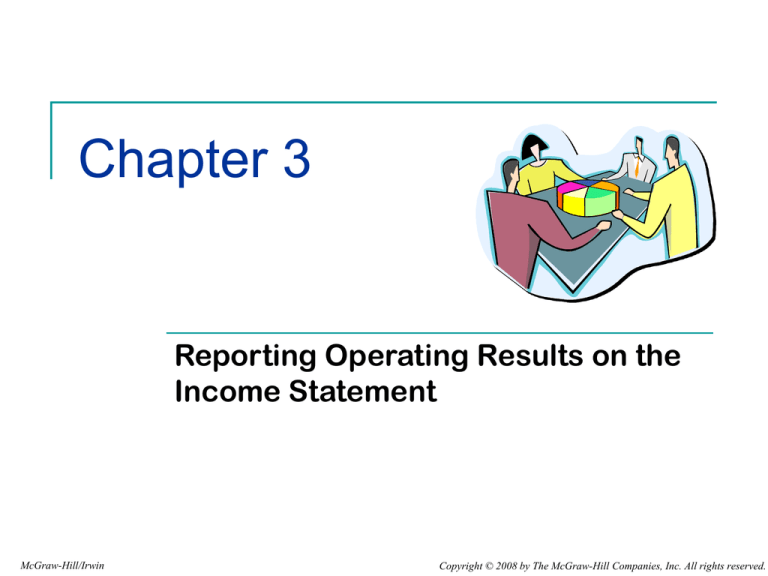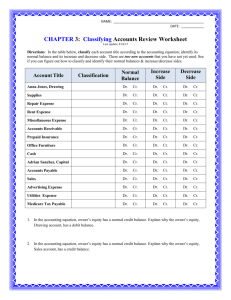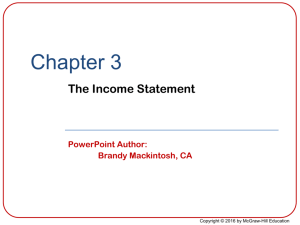
Chapter 3
Reporting Operating Results on the
Income Statement
McGraw-Hill/Irwin
Copyright © 2008 by The McGraw-Hill Companies, Inc. All rights reserved.
Toni Braxton’s Situation
Toni Braxton had no way of knowing that she was
headed for financial trouble since she had not
reviewed her personal income statement.
Revenues > Expenses = Net Income
Revenues < Expenses = Net Loss
3-2
Learning Objective 1
Describe common
operating transactions
and select appropriate
income statement
account titles.
3-3
Revenues and Expenses
Revenues are increases in a
company’s resources created by
sales of goods or services to
customers during the period.
SUPERCUTS
Income Statement
For the Month Ended September 30, 2008
Revenues
Haircut Revenue
$ 15,600
Total Revenue
15,600
Expenses are costs of business
necessary to earn revenues.
Expenses
Salaries and Wages Expense
Rent Expense
Utilities Expense
Advertising Expense
Insurance Expense
Total Expenses
Net Income
Net income is the excess of
revenues over expenses.
8,000
2,400
600
400
300
11,700
$ 3,900
3-4
Time Period Assumption
The time period
assumption assumes that
the long life of a company
can be divided into
shorter time periods, such
as months, quarters, and
years.
SUPERCUTS
Income Statement
For the Month Ended September 30, 2008
Revenues
Haircut Revenue
$ 15,600
Total Revenue
15,600
Expenses
Salaries and Wages Expense
Rent Expense
Utilities Expense
Advertising Expense
Insurance Expense
Total Expenses
Net Income
8,000
2,400
600
400
300
11,700
$ 3,900
3-5
Cash Basis Accounting
Cash basis accounting
records revenues when cash
is received and expenses
when cash is paid.
3-6
Cash Basis Accounting
The cash basis of accounting
doesn’t measure financial
performance very well when
transactions are conducted using
credit rather than cash.
3-7
Learning Objective 2
Explain and apply the
revenue and matching
principles.
3-8
Accrual Basis Accounting
Accrual Basis
Accounting
GAAP
Records revenues when they are
earned and expenses when they are
incurred, regardless of the timing of
cash receipts or payments.
3-9
Accrual Basis Accounting
Revenues are earned when
goods or services are provided
to customers at a determined
price and with reasonable
assurance of collection.
Expenses are incurred when
the economic benefits of an
item are used up in the current
period, resulting in a decrease
in the company’s resources.
3-10
Accrual Basis Accounting
The revenue principle is a
concept that requires that
revenues be recorded when
they are earned, rather than
when cash is received for them.
The matching principle is a
concept that requires that
expenses be recorded in the
period in which they are
incurred to generate revenue,
rather than the period in which
they are paid.
3-11
Timing of Reporting Revenue versus Cash Receipts
Company performs
promised acts.
Time
Revenue is
recorded here.
(2)
here
(1)
here
(3)
here
Cash can be received . . .
(1) Cash is received in the same period as the promised acts are performed.
(2) Cash is received in a period before the promised acts are performed.
(3) Cash is received in a period after the promised acts are performed.
3-12
Timing of Reporting Revenue versus Cash Receipts
Company performs
promised acts.
Time
Revenue is
recorded here.
(2)
here
(1)
here
(3)
here
Cash can be received . . .
(1) Cash is received in the same period as the promised acts are performed.
(2) Cash is received in a period before the promised acts are performed.
(3) Cash is received in a period after the promised acts are performed.
3-13
Timing of Reporting Revenue versus Cash Receipts
Company performs
promised acts.
Time
Revenue is
recorded here.
(2)
here
(1)
here
(3)
here
Cash can be received . . .
When
is received
areperformed.
performed,
(1)
Cash iscash
received
in the same before
period aspromised
the promisedacts
acts are
the company receiving the cash will report an increase in
cash and an increase in a liability, called unearned revenue,
(3) Cash is received in a period after the promised acts are performed.
which represents the obligation to perform the acts in the
future.
3-14
(2) Cash is received in a period before the promised acts are performed.
Timing of Reporting Revenue versus Cash Receipts
Company performs
promised acts.
Time
Revenue is
recorded here.
(2)
here
(1)
here
(3)
here
Cash can be received . . .
When
is received
actsacts
areare
performed,
(1)
Cash cash
is received
in the sameafter
periodpromised
as the promised
performed.
the
company performing the services will report an increase in
(2) Cash is received in a period before the promised acts are performed.
revenue and an increase in accounts receivable. Later, when
(3) Cash is received in a period after the promised acts are performed.
the cash is received, the accounts receivable is reduced.
3-15
Quick Check
The following transactions occurred during the month of September for
your Supercuts store.
1. Provided haircut services in September to customers for $15,000 cash.
2. Sold $300 of gift certificates in September.
3. Customers used $100 of gift certificates to pay for haircuts in September.
4. Provided $500 of hair styling services to employees of a local TV station,
which is billed monthly.
5. The TV station paid $300 on its account.
How much revenue would you report for September?
3-16
Quick Check
The following transactions occurred during the month of September for
your Supercuts store.
1. Provided haircut services in September to customers for $15,000 cash.
2. Sold $300 of gift certificates in September.
3. Customers used $100 of gift certificates to pay for haircuts in September.
4. Provided $500 of hair styling services to employees of a local TV station,
which is billed monthly.
5. The TV station paid $300 on its account.
How much revenue would you report for September?
(1) $
(3)
(4)
$
15,000
100
500
15,600
(2) Is unearned revenue because services
have not been provided at the time the gift
certificate were sold.
(5) Is a payment on an accounts receivable.
3-17
Timing of Reporting Expenses versus Cash Payments
Company incurs costs
to generate revenue.
Time
Expense is
recognized here.
(2)
here
(1)
here
(3)
here
Cash can be paid . . .
(1) Cash is paid at the same time as the cost is incurred to generate revenue.
(2) Cash is paid before the the cost is incurred to generate revenue.
(3) Cash is paid after the the cost is incurred to generate revenue.
3-18
Timing of Reporting Expenses versus Cash Payments
Company incurs costs
to generate revenue.
Time
Expense is
recognized here.
(2)
here
(1)
here
(3)
here
Cash can be paid . . .
(1) Cash is paid at the same time as the cost is incurred to generate revenue.
(2) Cash is paid before the the cost is incurred to generate revenue.
(3) Cash is paid after the the cost is incurred to generate revenue.
3-19
Timing of Reporting Expenses versus Cash Payments
Company incurs costs
to generate revenue.
Time
Expense is
recognized here.
(2)
here
(1)
here
(3)
here
Cash can be paid . . .
(1) Cash is paid at the same time as the cost is incurred to generate revenue.
Given the matching principle, the expense should be reported
(2)when
Cash isthe
paid
before
the costtoisearn
incurred
to generate
cost
is the
incurred
revenue
andrevenue.
not in the period
(3) Cash is paid after the thewhen
cost isthe
incurred
cashtoisgenerate
paid. revenue.
3-20
Timing of Reporting Expenses versus Cash Payments
Company incurs costs
to generate revenue.
Time
Expense is
recognized here.
(2)
here
(1)
here
(3)
here
Cash can be paid . . .
(1) Cash is paid at the same time as the cost is incurred to generate revenue.
Given the matching principle, the expense should be reported
(2)when
Cash isthe
paid
before
the costtoisearn
incurred
to generate
cost
is the
incurred
revenue
andrevenue.
not in the period
(3) Cash is paid after the thewhen
cost isthe
incurred
cashtoisgenerate
paid. revenue.
3-21
Learning Objective 3
Analyze, record, and
summarize the effects of
operating transactions,
using the accounting
equation, journal entries,
and T-accounts.
3-22
The Expanded Debit/Credit
Framework
Debit = Left
Credit = Right
Assets
=
Liabilities
+
Stockholders' Equity
+ Increases Decreases - Decreases Increases +
- Decreases Increases +
Debit
Credit
Asset accounts increase
on the left or debit
side and decrease
on the right or
credit side.
Debit
Credit
Liability accounts
increase on the right or
credit side and decrease
on the left or
debit side.
Debit
Credit
Stockholders’ equity
accounts increase on
the right or credit side
and decrease on the left
or debit side.
Remember this from Chapter 2?
Let’s take a closer look at the accounts that affect
Stockholders’ Equity.
3-23
The Expanded Debit/Credit
Framework
lities
+
Increases +
Stockholders' Equity
Contributed Capital
+
Retained Earnings
+
Stockholders' Equity
- Decreases Increases +
- Decreases Increases +
- Decreases Increases +
Debit
Credit
Debit
Credit
Revenues (& Gains)
Expenses (& Losses)
+
Stockhold
- Decreases Increases +
+ Increases Decreases - Decreases
Debit
Credit
Debit
Credit
3-24
Provided haircut services in September for
$15,000 cash.
Assets
Cash +15,000
=
Liabilities
Accounts
Cash (+A)
Haircut Revenue (+R, +SE)
Beg. Bal.
(a)
Cash
10,000
15,000
+
Stockholders' Equity
Haircut Revenue (R) +15,000
Debit
15,000
Credit
15,000
Haircut Revenue
Beg. Bal.
15,000 (a)
3-25
Sold $300 of gift certificates at the beginning
of September.
Assets
Cash +300
=
Liabilities
+
Unearned Revenue +300
Accounts
Cash (+A)
Unearned Revenue (+L)
Beg. Bal.
(a)
(b)
Cash
10,000
15,000
300
Stockholders' Equity
Debit
300
Credit
300
Uearned Revenue
Beg. Bal.
300 (b)
3-26
Provided $500 of haircut services to employees of a
local TV station, which is billed every month.
Assets
=
Accounts Receivable +500
Liabilities
Accounts
Accounts Reveivable (+A)
Haircut Revenue (+R, +SE)
Beg. Bal.
(c)
Accounts Reveivable
500
+
Stockholders' Equity
Haircut Revenue (+R) +500
Debit
500
Credit
500
Haircut Revenue
Beg. Bal.
15,000 (a)
500 (c)
3-27
Supercuts received a $300 payment from the
TV station.
Assets
=
Liabilities
+
Stockholders' Equity
Cash +300
Accounts Reveivable -300
Accounts
Cash (+A)
Accounts Reveivable (-A)
Beg. Bal.
(a)
(b)
(d)
Cash
10,000
15,000
300
300
Debit
300
Credit
300
Beg. Bal.
(c)
Accounts Reveivable
500
300 (d)
3-28
Supercuts paid stylists $8,100 for wages related to
services they provided in September.
Assets
Cash -8,100
=
Liabilities
Accounts
Wages Expense (+E, -SE)
Cash (-A)
Beg. Bal.
(a)
(b)
(d)
Cash
10,000
15,000
300
300
8,100 (e)
+
Stockholders' Equity
Wages Expense (+E) -8,100
Debit
8,100
Credit
8,100
Beg. Bal.
(e)
Wages Expense
8,100
3-29
On September 1, Supercuts paid $7,200 in advance
for September, October, and November rent.
Assets
Cash -7,200
Prepaid Rent +7,200
=
Accounts
Prepaid Rent (+A)
Cash (-A)
Beg. Bal.
(a)
(b)
(d)
Cash
10,000
15,000
300
300
8,100 (e)
7,200 (f)
Liabilities
+
Debit
7,200
Stockholders' Equity
Credit
7,200
Beg. Bal.
(f)
Prepaid Rent
7,200
3-30
On September 1, Supercuts paid $3,600 for an insurance
policy that covers the period from September 1 until
August 31 of next year.
Assets
Cash -3,600
Prepaid Insurance +3,600
=
Liabilities
Accounts
Prepaid Insurance (+A)
Cash (-A)
Beg. Bal.
(a)
(b)
(d)
Cash
10,000
15,000
300
300
8,100 (e)
7,200 (f)
3,600 (g)
+
Stockholders' Equity
Debit
3,600
Credit
3,600
Beg. Bal.
(g)
Prepaid Insurance
3,600
3-31
Supercuts received a bill for $400 for running a
newspaper ad about special back-to-school prices. The
bill will be paid in October.
Assets
=
Liabilities
Accounts Payable +400
Accounts
Advertising Expense (+E, -SE)
Accounts Payable (+L)
Accounts Payable
630 Beg. Bal.
400 (h)
+
Stockholders' Equity
Advertising Exp. (+E) -400
Debit
400
Credit
400
Beg. Bal.
(h)
Advertising Expense
400
3-32
Supercuts paid utility bills totaling $600 for services
received and billed in September.
Assets
=
Liabilities
+
Cash -600
Accounts
Utilities Expense (+E, -SE)
Cash (-A)
Beg. Bal.
(a)
(b)
(d)
Cash
10,000
15,000
300
300
8,100
7,200
3,600
600
(e)
(f)
(g)
(i)
Stockholders' Equity
Utilities Expense (+E) -600
Debit
600
Credit
600
Beg. Bal.
(i)
Utilities Expense
600
3-33
T-Account Balances
Beg. Bal.
(a)
(b)
(d)
End. Bal.
Beg. Bal.
Beg. Bal.
(c)
End. Bal.
Cash
10,000
15,000
300
300
8,100
7,200
3,600
600
(e)
(f)
(g)
(i)
6,100
Supplies
630
Accounts Reveivable
500
300 (d)
200
Here are the asset account
balances for your Supercuts
store. (Beginning balances
came from Chapter 2.)
Beg. Bal.
(f)
End. Bal.
Prepaid Rent
7,200
7,200
Beg. Bal.
(g)
End. Bal.
Prepaid Insurance
3,600
2,400
Beg. Bal.
Equipment
60,000
3-34
T-Account Balances
Accounts Payable
630 Beg. Bal.
400 (h)
1,030 End. Bal.
Here are the liability account
balances for your Supercuts
store. (Beginning balances
came from Chapter 2.)
Uearned Revenue
Beg. Bal.
300 (b)
300 End. Bal.
Notes Payable
20,000 Beg. Bal.
3-35
T-Account Balances
Contributed Capital
50,000 Beg. Bal.
Haircut Revenue
15,000
500
15,500
Beg. Bal.
(e)
End. Bal.
Wages Expense
8,100
8,100
Beg. Bal.
(a)
(c)
End. Bal.
Here are the stockholders’ equity
account balances for your
Supercuts store. (Beginning
balances came from Chapter 2.)
Beg. Bal.
(h)
End. Bal.
Advertising Expense
400
400
Beg. Bal.
(i)
End. Bal.
Utilities Expense
600
600
3-36
Learning Objective 4
Prepare an unadjusted
trial balance.
3-37
Unadjusted Trial Balance
SUPERCUTS
Unadjusted Trial Balance
As of September 30, 2008
Debit
Credit
Cash
$
6,100
Supplies
630
Accounts Receivable
200
Prepaid Rent
7,200
Prepaid Insurance
3,600
Equipment
60,000
Accounts Payable
$
1,030
Unearned Revenues
300
Notes Payable
20,000
Contributed Capital
50,000
Haircut Revenue
15,500
Wages Expense
8,100
Utilities Expense
600
Advertising Expense
400
Total
$ 86,830 $ 86,830
Amounts
come from
ledger
balances
Not a
financial
statement
Debits = Credits
Listed in
financial
statement
order
3-38
Unadjusted Trial Balance
SUPERCUTS
Unadjusted Trial Balance
As of September 30, 2008
Debit
Credit
Cash
$
6,100
Supplies
630
Accounts Receivable
200
Prepaid Rent
7,200
Prepaid Insurance
3,600
Equipment
60,000
Accounts Payable
$
1,030
Unearned Revenues
300
Notes Payable
20,000
Contributed Capital
50,000
Haircut Revenue
15,500
Wages Expense
8,100
Utilities Expense
600
Advertising Expense
400
Total
$ 86,830 $ 86,830
Some adjustments will have to
be made at the end of the
accounting period to update
the accounts.
For example, at the end of
September, do we still have 3
months of Prepaid Rent left to
use? No, we used up 1/3 of the
rent in September.
We will look more closely at
adjustments in Chapter 4.
3-39
Accounting for Revenues and Expenses
(1) Cash is received in
the same period the
company delivers
goods/services.
$
(3) Cash is received
after the company
delivers
goods/services.
dr. Cash
cr. Service Revenue
(2) Cash is received
before the company
delivers
goods/services.
dr. Cash
dr. Accounts Rec.
cr. Accounts Rec.
$
cr. Service Revenue
dr. Cash
cr. Unearned Rev.
$
dr. Unearned Rev.
cr. Service Revenue
3-40
Accounting for Revenues and Expenses
(1) Cash is paid in the
same period the
expense is incurred.
$
(3) Cash is paid after the
expense is incurred.
dr. Business Expense
cr. Cash
dr. Accounts Payable
(2) Cash is paid before
the expense is
incurred.
dr. Business Expense
cr. Cash
$
cr. Accounts Payable
dr. Prepaid Expense
cr. Cash
$
dr. Business Expense
cr. Prepaid Expense
3-41
Learning Objective 5
Describe limitations of
the income statement.
3-42
Income Statement Limitations
NI Cash
NI Value
NI Precise
3-43
Ethical Insights
Bernie Ebbers, CEO, WorldCom
Recorded expenses as assets
Sentenced to 25 years
Martin Grass, CEO, Rite Aid Corp.
Recorded rebates before earned
Sentenced to 8 years
Barry Minkow, CEO, ZZZZ Best
Recorded fraudulent sales
Sentenced to 25 years
3-44
Chapter 3
Supplement
Account Names
McGraw-Hill/Irwin
Copyright © 2008 by The McGraw-Hill Companies, Inc. All rights reserved.
Chart of Accounts
Account Name
Sales Revenues
Service Revenues
Rental Revenues
Interest Revenues
Dividend Revenues
Other Revenues
Cost of Goods Sold
Repairs & Maintenance
Advertising Expense
Depreciation Expense
Insurance Expense
Salaries & Wages Expense
Rent Expense
Supplies Expense
Transportation Expense
Utilities Expense
Amortization Expense
Interest Expense
Income Tax Expense
Description
Revenues
Sales of products in the ordinary course of business
Sales of services in the ordinary course of business
Amounts earned by renting out company property
Amounts earned on savings accounts and certificates of deposit
Dividends earned from investing in other companies
Miscellaneous sources of revenues
Expenses
Cost of products sold in the ordinary course of business
Cost of routine maintenance and upkeep of buildings/equipment
Cost of advertising services obtained during the period
Cost of plant and equipment used up during the period
Cost of insurance coverage for the current period
Cost of employees' salaries and wages for the period
Cost of rent for the period
Cost of supplies used up during the period
Cost of freight to transport goods out to customers
Cost of power, light, heat, internet, and telephone for the period
Cost of intangible assets used up or expired during the period
Interest charged on outstanding debts owed
Taxes charged on reported earnings
3-46
End of Chapter 3
3-47






